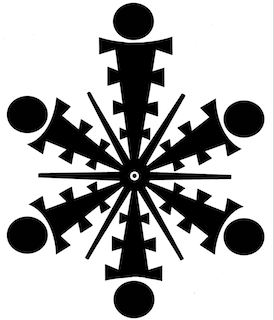
Eye Exercises
This Exercises are for Eye Muscle Strengthening ONLY. Your Spectacle power neighter reduce with this nor with any other miraculous eye exercises. This only helps for eye relaxation and relieves eye strain.
Vision is an active process provided not only by the eyes, but also by the work of the brain. In addition to the eyes, the visual system also includes nerve pathways, visual centers. Vision with each eye separately is worse than vision with two eyes. This is due to the processes of information processing in the brain.
Eye exercises can be done in following ways.
- Manual Eye Strengthening Exercises
- Exercises aided with Special Devices
- Eye Relaxation Exercises - Palming
1. Manual Eye Exercises
- Eye exercises to improve accommodation
- Eye exercises to improve Extraocular Muscle Power
- Eye exercises to improve circulation of Blood and Intraocular fluid
A. Eye exercises to improve accommodation
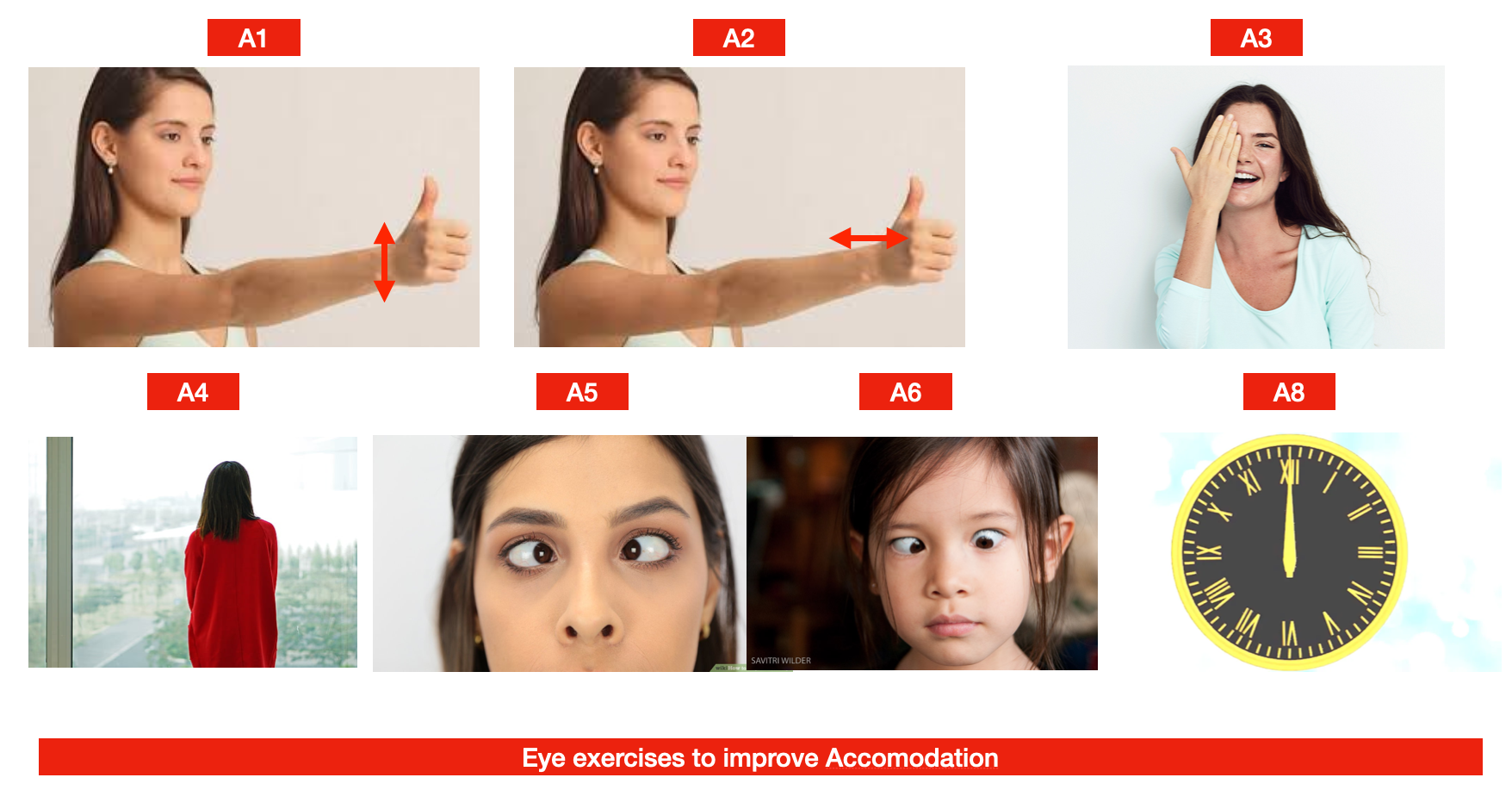
A1: Performed while Standing. Look forward in front of you for 2-3 seconds, then move your gaze to the index finger or thumb of your right hand, located in front of the face at the level of the nose at a distance of 25-30 cm, after 3-5 seconds lower your hand. Repeat the exercise 10-12 times.
A2: Performed while Standing. Look at the index finger of the outstretched face of the left hand for 2-3 seconds. Then, bending your hand, bring it closer to your nose until your finger begins to double. Repeat the exercise 6-8 times. With the right exercise, your eyes will rest. If you have achieved this, proceed to the next exercise.
A3: Performed while Standing. Performed while standing. Look for 3-5 seconds at the index finger of the outstretched right hand, then cover your left eye with the palm of your left hand for 3-5 seconds, and bend and unbend your right hand at this time. Now do the same, just cover your right eye with your right hand. Repeat the exercise 6-8 times.
A4: Performed while Standing. It is called a "mark on the glass". Stand at a distance of 30-35 cm from the window glass, on which a round colored mark with a diameter of 3-5 mm is attached at eye level. Away from the line of sight passing through this mark, outline an object for visual fixation. Look at the mark for 1-2 seconds (if you are wearing glasses, then without taking off your glasses), then for 1-2 seconds move your gaze to the intended object. Now turn your gaze alternately at the mark, then at the object. In order not to cause fatigue, remember that the first two days the duration of the lesson is no more than three minutes, the next two days the time can be increased to five minutes, after another two days - up to seven minutes. Exercise can be performed not only with two, but also with one eye 2-3 times a day for 15-20 days and repeat it regularly at intervals of 10-15 days.
A5: Can be done while sitting, standing, or lying down. Look with both eyes at the space between the eyebrows and try to keep your gaze in this position for five seconds. Add one second each subsequent day until the exercise lasts for one to two minutes.
A6: Look with both eyes at the tip of the nose and hold your gaze in this position for five seconds. Add one second a day until you reach one or two minutes for the session.
A7: This can also be done while sitting, standing, or lying down. Look with both eyes at the left or right shoulder and hold your gaze in this position for five seconds. Add one second a day until you work up to one to two minutes a day.
A8: .Rotate both eyes clockwise, fixing your gaze at the space between the eyebrows and the tip of the nose, then do the same in the opposite direction Repeat the exercise four to five times.
B. Eye exercises to improve Extraocular Muscle Power
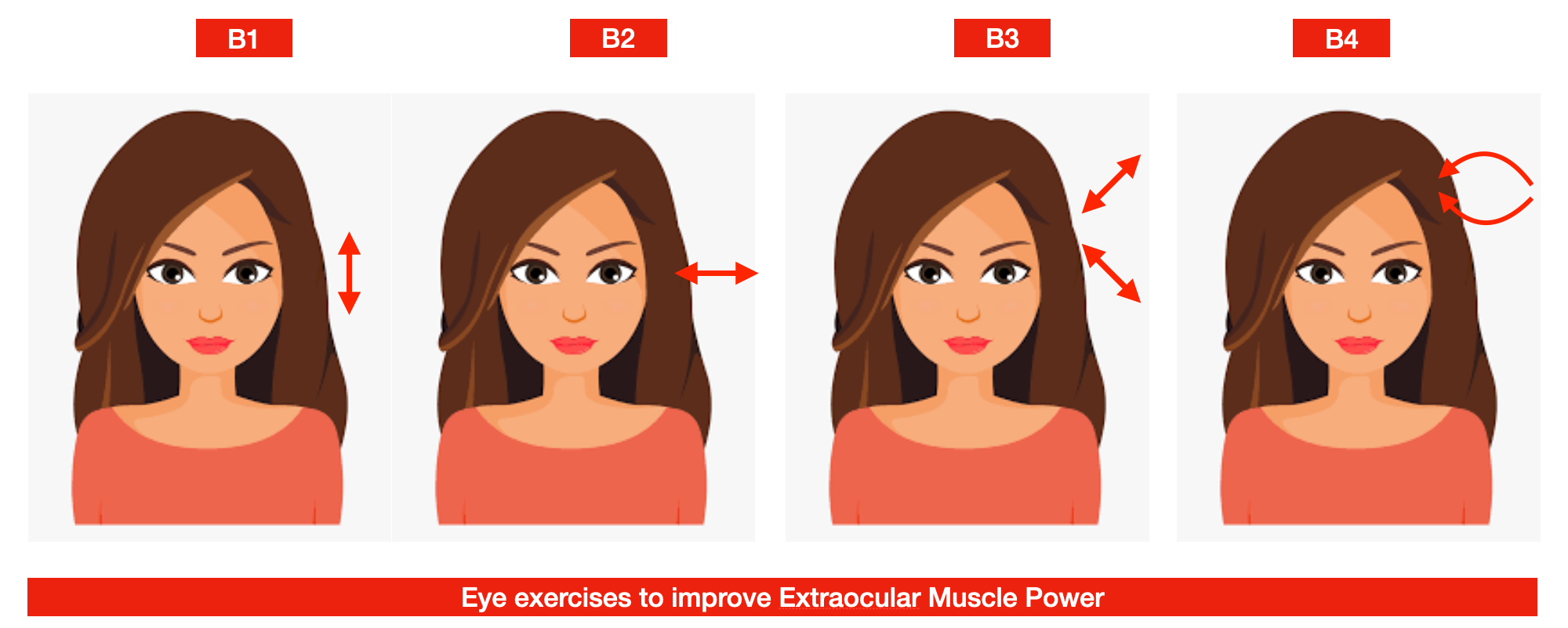
B1: Sit down. Slow movements of the eyes vertically up and down. Look at the floor, then at the ceiling. Try to perform movements only with your eyes, do not turn your head. Repeat 8-10 times.
B2: Sit down. The movements are similar to the first exercise, only horizontally. Repeat 8-10 times.
B3: Sit down. A similar exercise, only eye movements are performed diagonally. Repeat 8-10 times.
B4: Circular movements of the eyes. Clockwise first, then counterclockwise. Repeat 4-6 times.
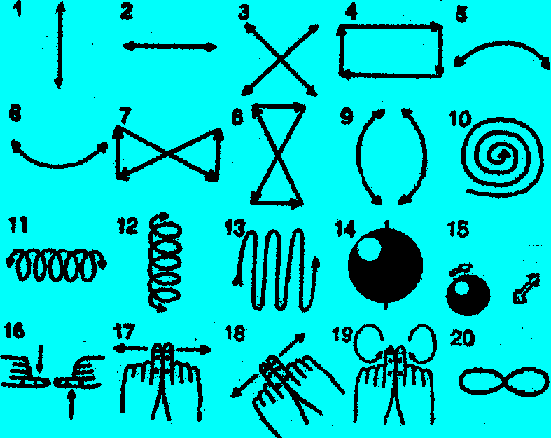
C. Eye exercises to improve circulation of Blood and Intraocular fluid
C1: Sit down. Close your eyelids for 3-5 seconds. Then open wide at the same time. Repeat 6-8 times. Each phase of the exercise can be done with inhalation and exhalation.
C2: Sit down. Blink your eyes quickly for 10-15 seconds. Repeat 6-8 times. Each phase of the exercise can be done with inhalation and exhalation.
C3: Sit down. Close your eyelids and gently massage with your index fingers in a circular motion. Lead time 1 minute. Set a timer. Do not press on your eyes.
C4: Sit down. Close your eyes and use three fingers of each hand (index, middle, and ring) to press down on your eyes through your upper eyelids for 1-3 seconds. Don't press hard!
C5: Sit down. Place the index fingers of each hand on the skin of the corresponding browbone and close your eyes. While holding the skin, the fingers must resist the muscles of the upper eyelids and forehead. Repeat 6-8 times.
2: Exercises aided with Special Devices
Many softwares, hardware programs and toys are available now-a-days.
Get some details from www.amblyoplay.com
3. Eye Relaxation Exercise - Palming
This exercise is designed to maximize eye muscle relaxation. Palming relieve visual and nervous eye strain.
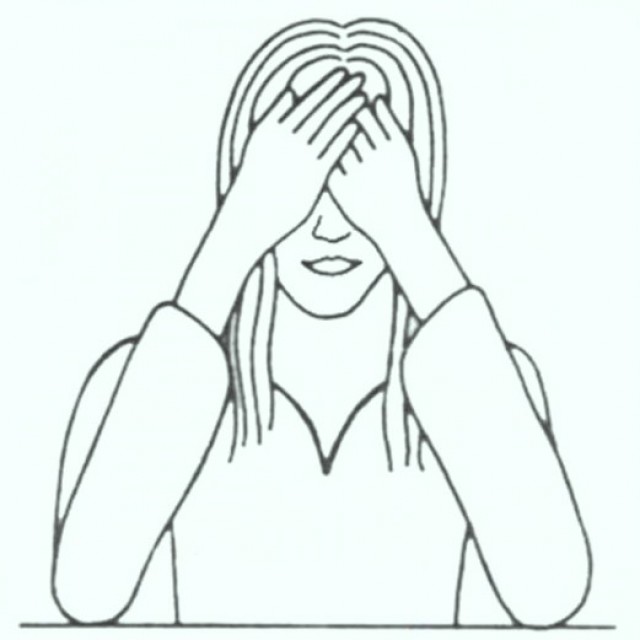
The essence of palming for the eyes
Effect of Palming is to give rest to the entire visual system by eliminating visual stimulation. Merely closing the eyes is not appropriate, as light can still enter through closed eyelids. And by covering your eyes with your palms, you can completely exclude the hit of light rays on the retina.
In addition, the warmth from the hands is transferred to the eyes, which also promotes relaxation.
According to Ancient Indian medicine, the human palm has a high energy potential. Therefore, the use of hands in palming also allows you to get a kind of "bioenergetic" nutrition for the eyes. Currently, many ophthalmologists recommend this exercise to their patients in order to relieve accommodation spasm and prevent visual impairment.
However, it is not possible to fully restore vision with the help of palming. However, the exclusion of light stimuli, coupled with the therapeutic effects of heat and energy of the palms, still has a positive effect on the entire visual system.
How to do palming?
First, take off your glasses or contact lenses. To be fair, it should be noted that palming performed with a contact lens is better than palming not done at all. It can be performed both sitting and lying down, below will be a description of the technique for each position.
Sitting position
Place your palms on a hard surface Or, rest your elbows on your knees. Try to relax the muscles in your back, neck, arms, legs. When performing palming, the ultimate goal is to achieve maximum mental and nervous relaxation, therefore 70% of the effectiveness of this exercise depends on the chosen posture.
After choosing a pose, carefully rub your palms until a pleasant feeling of warmth in them. Next, cover your eyes with your palms so that the edges of the palms cover the nose, and the closed fingers cross each other. The palms should not touch or press on the eyes. To do this, you need to give them the shape of a "boat". Look carefully at the picture, your task is to do the same.
Next, open your eyes. If you see light through your fingers, close your fingers in such a way as to exclude it from entering. It is advisable to turn off the bright light in the room beforehand.
After making sure your palms are blocking out light, close your eyes.
Lying position
Lie on your back, rub against each other and close your hands as described above. In this position, your elbows will be on your weight, which will create a little tension. However, a number of people like this palming technique more than sitting. True, the risk of falling asleep increases. That in principle does not contradict the basic concept of the exercise - to achieve maximum relaxation.
After you have decided on the posture, relaxed and closed your eyes, the actual phase for the main exercise begins.
Can palming improve vision?
No.
Palming will not work to restore vision with the help of this exercise. However, it is quite possible to have a positive effect on the visual system.
Avoid mistakes while doing Palming
- do not press on the eyes, palms should not touch the eyes.
- do not let the light pass through your palms, close your fingers closer, but do not overextend them. Remember, maximum relaxation is the main principle of palming.
- uncomfortable posture. If you initially assumed an uncomfortable position, then you will not be able to perform the exercise well.
How often to palming?
Palming is suggested for 20-40 seconds, but at least several times a day.
If you regularly do eye exercises, then you will achieve the best result if you perform at least three minutes of palming before training and the obligatory 5-10 minutes at the end of the training.
In general, this exercise perfectly relieves visual fatigue, therefore it is very willingly recommended by ophthalmologists to patients whose professional activity is related to a computer. Every 30-60 minutes, it is advisable to break away from the computer monitor and do light exercises for the eyes and two to three minutes of palming.
Also, at the end of the working day or in the evening already being at home, it is desirable to devote 5 to 10 minutes to this exercise.
These all details in just for basic information about the diseases. Please consult your doctor before following this by yourself. --- Dr Dhaval Patel (MD, AIIMS Delhi)
- compiled & published by Dr Dhaval Patel MD AIIMS